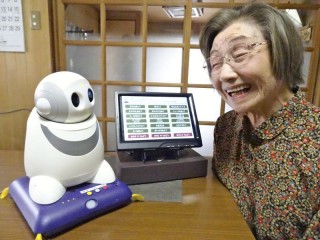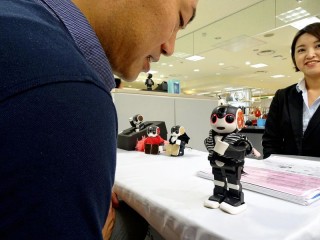Loading
Search
▼ Bringing Robots Home Eases Loneliness
- Category:Other
The city of Saijo in Ehime Prefecture faces the Seto Inland Sea to the north and Mt. Ishizuchi, the tallest mountain in western Japan, to the south. Here, 87-year-old Setsuko Saeki has lived with a robot for a year in her spacious house at the foot of a mountain.
When she gets out of bed in the morning and enters the living room, she’s greeted by her robot, a model named “PaPeRo i,” on a desk. “Good morning, Setsuko-san,” is a typical address. “Did you sleep well?”
“When it spoke to me the first time, I couldn’t help but feel excited,” Saeki said. “No one had called me by name and said good morning for a long time.”
Her three children are on their own now, and her husband passed away six years ago. Since then, Saeki has lived alone.
Nursing care helpers visit her daily, and she regularly attends gatherings to enjoy her hobby of haiku poetry. Even so, she’d often felt a loneliness that was hard to describe.
In July last year, the city government began an experimental project to lend PaPeRo i robots free of charge to 10 elderly residents in the city. At the request of family members of elderly residents who live separately, the city government lent out the robots for three months.
Saeki’s eldest son, who lives in Chiba Prefecture, learned about the project on the city government’s website and applied on Saeki’s behalf.
A PaPeRo i robot is about 30 centimeters tall. When Saeki asks it, “What time is it?” it replies as its cheeks light up red.
Cameras are installed in its big eyes, and it follows Saeki using the camera sensors, directing its face toward her. Before she goes to bed, the robot asks, “Did you lock up the house?” Sometimes, the robot makes impromptu puns and tells her pieces of trivia.
When she gets out of bed in the morning and enters the living room, she’s greeted by her robot, a model named “PaPeRo i,” on a desk. “Good morning, Setsuko-san,” is a typical address. “Did you sleep well?”
“When it spoke to me the first time, I couldn’t help but feel excited,” Saeki said. “No one had called me by name and said good morning for a long time.”
Her three children are on their own now, and her husband passed away six years ago. Since then, Saeki has lived alone.
Nursing care helpers visit her daily, and she regularly attends gatherings to enjoy her hobby of haiku poetry. Even so, she’d often felt a loneliness that was hard to describe.
In July last year, the city government began an experimental project to lend PaPeRo i robots free of charge to 10 elderly residents in the city. At the request of family members of elderly residents who live separately, the city government lent out the robots for three months.
Saeki’s eldest son, who lives in Chiba Prefecture, learned about the project on the city government’s website and applied on Saeki’s behalf.
A PaPeRo i robot is about 30 centimeters tall. When Saeki asks it, “What time is it?” it replies as its cheeks light up red.
Cameras are installed in its big eyes, and it follows Saeki using the camera sensors, directing its face toward her. Before she goes to bed, the robot asks, “Did you lock up the house?” Sometimes, the robot makes impromptu puns and tells her pieces of trivia.
Three times a day, the robot asks her, “Setsuko-san, may I take photos of you?” The robot photographs her and transmits the images to her eldest son’s smartphone or personal computer. Her son also sends photos that Saeki can see on a device connected to her robot.
The photos are likewise transmitted to a care manager in charge of Saeki’s case, which gives her additional peace of mind, and she can exchange voices messages with her eldest son and his family via the robot.
“Initially, I didn’t expect anything after hearing about a robot. But now, I don’t want to be parted from my PaPeRo,” Saeki said.
Mitsuaki Matsuo, chief of the city government’s comprehensive support section, said, “The responses were better than we expected.”
Initially, some elderly residents in the city voiced negative opinions about the robot-lending project. One said, “If I have to receive care from a robot, it’s over.” But about 90 percent of the people who used the robots had positive things to say, such as “I feel close to it” and “I can ease my loneliness.”
Also, about 90 percent of the families of the users praised the project, saying it relieved their anxiety.
Later, the city government made the service a paid rental business. The fees are ¥22,530 for installment and ¥6,000 a month for telecommunication and other necessary features, both excluding consumption tax.
Six residents, including those who have continued to use the service, now live with the robots.
Matsuo said: “Users’ family members and local human resources will be increasingly aged in the years to come. We want to build a system for monitoring residents, borrowing the strengths of robots.”
Older people more interested
In a survey by the Internal Affairs and Communications Ministry in 2015, 40 percent of respondents in their 20s or younger said they “want to use” or “could consider using” communication robots.
The percentage among people in their 50s was 51 percent, and that among people in their 60s or older was 55 percent. The higher respondents’ age, the more likely they were to want to use such robots.
However, there are many elderly people who are also hesitant to buy robots for fear they may be difficult to use. For such people, Benefit Japan Co., an Osaka-based firm selling Sharp Corp.’s small RoBoHoN model robots, holds free events at which visitors can control real RoBoHoN robots, in department stores and shopping malls across the nation.
A RoBoHoN is about 20 centimeters tall and includes such functions as a smartphone through which users can access a telephone, email and camera.
A Benefit Japan official said: “Users can take photos in travel destinations and chat about the memories later. Many people are surprised at how many functions the robots have, despite their very small size.”
Takashimaya Co. opened the Robotics Studio, which the company claims is the first sales corner in a department store specializing in robots, in its Shinjuku store in Tokyo in 2017. The following year, the company opened the same kind of sales corner in its store in Osaka.
At both locations, customers can experience various means of controlling robots.
In Takashimaya’s Osaka store, officials said, robots are bought by not only elderly people who want to enjoy using them, but also many people in their 40s to 50s who buy them to keep watch over their parents.
Sales in the robot corners have been brisk, and the company plans to open Robotics Studio corners in more places nationwide.
Desire to chat can be realized
The main feature of communication robots is that they understand human words, recognize their users’ faces, and chat and make gestures that endear them to users.
Such robots are said to be priced mainly from the ¥100,000 to ¥300,000 levels.
In a survey conducted by the Cabinet Office in fiscal 2017, more than 10 percent of respondents who lived alone at age 55 or older said they had conversations with family members or friends “once or twice a month” or “rarely.”
Prof. Hiroshi Ishiguro of Osaka University voiced his expectations, saying, “Robots can fulfill people’s desire to chat with somebody, and make users feel close to them and warm with their eye contact, motions and words. They could become as popular as smartphones, if prices go down.”
Later, the city government made the service a paid rental business. The fees are ¥22,530 for installment and ¥6,000 a month for telecommunication and other necessary features, both excluding consumption tax.
Six residents, including those who have continued to use the service, now live with the robots.
Matsuo said: “Users’ family members and local human resources will be increasingly aged in the years to come. We want to build a system for monitoring residents, borrowing the strengths of robots.”
Older people more interested
In a survey by the Internal Affairs and Communications Ministry in 2015, 40 percent of respondents in their 20s or younger said they “want to use” or “could consider using” communication robots.
The percentage among people in their 50s was 51 percent, and that among people in their 60s or older was 55 percent. The higher respondents’ age, the more likely they were to want to use such robots.
However, there are many elderly people who are also hesitant to buy robots for fear they may be difficult to use. For such people, Benefit Japan Co., an Osaka-based firm selling Sharp Corp.’s small RoBoHoN model robots, holds free events at which visitors can control real RoBoHoN robots, in department stores and shopping malls across the nation.
A RoBoHoN is about 20 centimeters tall and includes such functions as a smartphone through which users can access a telephone, email and camera.
A Benefit Japan official said: “Users can take photos in travel destinations and chat about the memories later. Many people are surprised at how many functions the robots have, despite their very small size.”
Takashimaya Co. opened the Robotics Studio, which the company claims is the first sales corner in a department store specializing in robots, in its Shinjuku store in Tokyo in 2017. The following year, the company opened the same kind of sales corner in its store in Osaka.
At both locations, customers can experience various means of controlling robots.
In Takashimaya’s Osaka store, officials said, robots are bought by not only elderly people who want to enjoy using them, but also many people in their 40s to 50s who buy them to keep watch over their parents.
Sales in the robot corners have been brisk, and the company plans to open Robotics Studio corners in more places nationwide.
Desire to chat can be realized
The main feature of communication robots is that they understand human words, recognize their users’ faces, and chat and make gestures that endear them to users.
Such robots are said to be priced mainly from the ¥100,000 to ¥300,000 levels.
In a survey conducted by the Cabinet Office in fiscal 2017, more than 10 percent of respondents who lived alone at age 55 or older said they had conversations with family members or friends “once or twice a month” or “rarely.”
Prof. Hiroshi Ishiguro of Osaka University voiced his expectations, saying, “Robots can fulfill people’s desire to chat with somebody, and make users feel close to them and warm with their eye contact, motions and words. They could become as popular as smartphones, if prices go down.”
- August 19, 2019
- Comment (0)
- Trackback(0)




